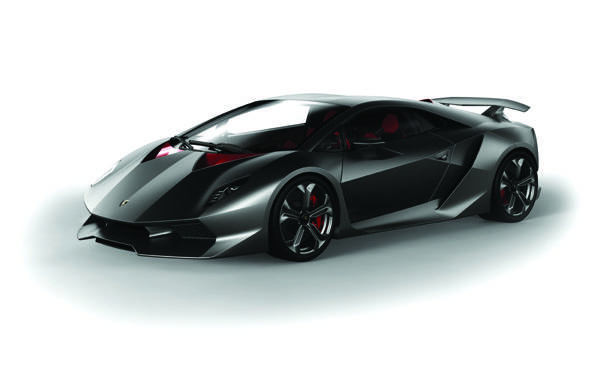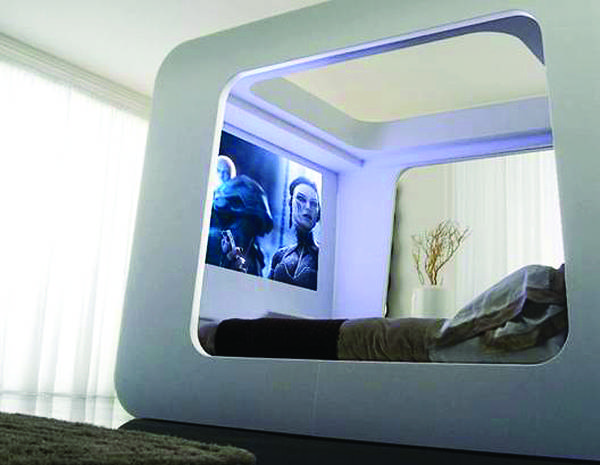Lamborghini Sesto Elemento
Like an F-117 stealth fighter plane designed by Darth Vader, Lamborghini’s new Sesto Elemento concept car could easily be confused for a futuristic vehicle from some sci-fi movie. Considering that the car’s name literally translates to “Sixth Element,” one could hardly be blamed for wondering if Bruce Willis was at the wheel when the car debuted at the Paris Motor Show. As it turns out, the Sesto Elemento is actually named for the 6th element of the periodic table, which is (as any chemistry student knows) carbon.
Lamborghini enthusiasts will salivate at such astounding performance, as well as the Sesto’s trademark Lambo design.
Carbon fiber is all the rage in today’s supercar segment—a weight reducing performance enhancer that is used in everything from structural body components to interior decorations. But Lamborghini has predicated its design philosophy on the integration of carbon fiber and has declared that it is the only manufacturer in the world to have mastered the complete carbon-fiber reinforced plastic process across a range of technologies. This would seem a rather bold claim given the widespread use of carbon fiber throughout the industry, although Lambo’s models place an unusually high premium on weight reduction. With just a smidgeon of aluminum thrown in, the Sesto tips the scales at only 2,202 lbs.
Of course, lightweight is only half the equation. The other half, power, comes in the form of the transversely rear-mounted 5,204 cc V-10 engine. Capable of developing 570 horsepower at 8,000 rpm, the V-10 reportedly launches the Sesto to 62 mph in an unfathomable 2.5 seconds with a top speed of 186 mph. Lamborghini enthusiasts will salivate at such astounding performance, as well as the Sesto’s trademark Lambo design. Despite some early reports that pegged this as a replacement for the Murcielago, the Sesto Elemento is a concept only, albeit one whose investigation of carbon fiber integration will inform Lamborghini models for decades to come. – Mike Daly
2011 Jaguar XJL
The term “all-new” is thrown around rather frequently during vehicle launches, but the case of the Jaguar XJL, the maxim is well applied. As recently as 2008, the XJ wore an exterior design that remained relatively unchanged since 1968. Design Director Ian Callum sought to completely re-imagine the XJ lines, a goal he has accomplished with a higher beltline and a sloping rear fastback. The front fascia has also been drastically revised, most notably with thin xenon headlamps that replace the former double-lens wide eyes with a slanted squint, instantly conjuring the image of a purring cat.
Callum’s team further conducted their makeover with a luxury sensibility, employing an unprecedented amount of leather and burled wood in the cabin. These fine aesthetic details are bolstered by amenities like an 8-inch touchscreen infotainment display, and plush leather seats.
The car also integrates sporting features in ways that demonstrate Jag’s continued commitment to its traditional identity. This motif is most dramatically affected by the engine, a 5.0 liter V-8 that is available in three configurations. The base V-8 is good for 385 horsepower and 5.4 seconds to 60 mph, a supercharged version lifts horsepower to 470 and quickens launch times to only 4.9 seconds. And through extensive use of aluminum, the XJ’s weight has been reduced by about 300 pounds, making it the lightest luxury sedan in its class.
With a wonderfully sensitive accelerator pedal, the XJ is remarkably quick for such a large car. Further nods to sporting aspirations are found in the Dynamic Mode, which changes shift points and stiffens the suspension. Activating this feature also changes the car’s main instrument console from its default blue to a more exciting red. The new Jaguar is not only doing something different, but with ostentatious flair, no less. – Mike Daly
iPad Wine List
Drinking wine remains an age-old tradition, but the way we select wine is progressing. Upscale restaurants around the world are introducing guests to the interactive, touch-screen sommelier. Upon being sat, diners are surprised to find an iPad placed in their hands, connecting them to the digital age of wine pairing . Touch-pad links instantaneously spitt out detailed descriptions of thousands of wine labels, regions, varietals, and ratings.
Since the iPad’s introduction, many high-end restaurants are already seeing salient boosts in wine sales. Supporters are looking forward to influencing a younger generation to embrace wine-savviness, while critics fear that it is set to distract society from the sacred tradition of mealtime. But such innovations in technology are what lead our dinner conversations today. And where better to welcome the high-tech novelty than at an esteemed restaurant, sipping the perfect pour, directly chosen by you and your fellow diners. – Diana Gdula
Craft Torpedo
It’s only fitting that a speedy yacht model is called a Torpedo. These colorful 41-footers are capable of speeds nearing 50 knots. Of course, there’s more to the Torpedo than just speed. J Craft uses fiberglass for the hull for ease of maintenance but insists on mahogany for the decks for classic appeal. And the Torpedos are available in more than a dozen different hull tones.
J Craft has certainly done well for itself, taking orders for eight Torpedos so far this year and planning 12 to 16 launches for next year. Each J Craft is built entirely on an as-ordered basis to tailor to a buyer’s tastes. The 265-gallon fuel capacity and twin Volvo Penta IPS500 engines permit a 350-nautical-mile range at 43 knots, ideal for weekend trips or just poking around a handful of ports. In addition, the IPS drive system for the engines is so intuitive—featuring an easy-to-use joystick control—even a buyer new to boating will feel at ease at the helm.
The standard J Craft Torpedo is €750,000 ($1.022 million at press time), plus tax and delivery. – Diane M. Byrne
Hi-Can Bed from Avant Gallery
Avant Gallery’s contemporary take on the classic canopy bed recreates the most intimate space inside the bedroom. The Hi-Can, high fidelity canopy, is made by Italian designer Edoardo Carlino featuring cutting-edge technological advancements and incorporating regal elegance for a brand new concept of comfort and relaxation.
The bed provides remote controlled blinds and a pressure-balance bedding system that self-regulates for orthopedically-correct support. It also comes equipped with a home theater screen sliding down at the foot of the bed with a full entertainment console, state-of-the-art sound system, and LED reading lights. All system features are enabled through the ease of an iPod, iPhone or iPod touch-screen remote.
The bed’s wooden structure is made of blockboard panels, Nappa leather upholstery, and a headboard covered with a layer of Altuglas acrylic gloss. Avant Gallery has made your high-tech bed, now lie in the Hi-Can and drift off to sleep in haute style.
The Hi-Can is available online at www.avantgallery.com. – Diana Gdula










![J Craft Boats[1]](http://www.hauteliving.com/wp-content/uploads/2010/10/J-Craft-Boats1.jpg)













